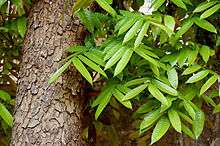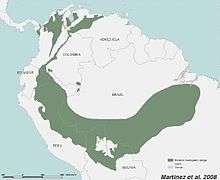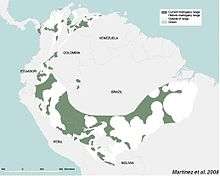Swietenia macrophylla
Swietenia macrophylla, commonly known as mahogany,[2] Honduran mahogany,[2] Honduras mahogany,[3] big-leaf mahogany,[4] or West Indian mahogany,[5] is a species of plant in the Meliaceae family. It is one of three species that yields genuine mahogany timber (Swietenia), the others being Swietenia mahagoni and Swietenia humilis. It is native to South America and Mexico, but naturalized in the Philippines, Singapore and Hawaii,[2][6] and cultivated in plantations and wind-breaks elsewhere.[5]
| Swietenia macrophylla | |
|---|---|
 | |
| Scientific classification | |
| Kingdom: | Plantae |
| Clade: | Tracheophytes |
| Clade: | Angiosperms |
| Clade: | Eudicots |
| Clade: | Rosids |
| Order: | Sapindales |
| Family: | Meliaceae |
| Genus: | Swietenia |
| Species: | S. macrophylla |
| Binomial name | |
| Swietenia macrophylla | |
 | |
| Historic range of big-leaf mahogany in South America | |
 | |
| Current range of big-leaf mahogany in South America | |
| Synonyms[1] | |
| |
Description
Wood
Mahogany wood is strong and is usually a source for furniture, musical instruments, ships, doors, coffins, decors.[7]
Leaves
Mahogany is characterised by its large leaves (up to 45 cm long). The leaflets are even in number and are connected by a central midrib.[7]
Fruits
The fruits are called "sky fruits" because of its upwards growth towards the sky. The fruits of mahogany can be measure to 40 cm in length, in a light grey to brown capsule. Each fruit capsule could contain 71 winged seeds.[7]
Seeds
The seeds of mahogany can reach 7 to 12 cm long.[7]
Timber
Unlike mahogany sourced from its native locations, plantation mahogany grown in Asia is not restricted in trade. The mahogany timber grown in these Asian plantations is the major source of international trade in genuine mahogany today. The Asian countries which grow the majority of Swietenia macrophylla are India, Indonesia, Malaysia, Bangladesh, Fiji, Philippines, Singapore, and some others, with India and Fiji being the major world suppliers. The tree is also planted in Laos PDR.
Medicinal use
There are also claims of its ability to improve blood circulation and skin condition, as well as anti-erectile dysfunction.[8]
However, there are reports of liver injury or hepatotoxicity after consumption of Mahogany Seeds both in raw form[9]and raw seeds grind and pack in capsule form.[10] The severity of liver damage varies. There are also the report of single case kidney injury and polyarthralgia. In most cases, the liver function was recovered after stopping the consumption.[9] The exact mechanism of these adverse events is currently unknown.[11]
These cases that happened are the first reports of Swietenia Macrophylla seeds’ association with liver injury.[9] This may also due to over dosage and consumption of contaminated raw seeds which are never been thoroughly investigated. Based on acute oral toxicity studies of Swietenia Macrophylla seeds, the consumption of Swietenia Macrophylla by humans is safe if the dose is less than 325 mg/kg body weight. The usual dose of Swietenia Macrophylla prescribed in Malaysian folk-lore medicine is one seed per day.[12]
Common names
The species is also known under other common names, including bastard mahogany,[13] broad-leaved mahogany, Brazilian mahogany, large-leaved mahogany, genuine mahogany, tropical American mahogany, and sky fruit, among others.
- English - big leaf mahogany, large-leaved mahogany, Brazilian mahogany
- French - Acajou à grandes feuilles, acajou du Honduras
- Spanish - caoba, mara, mogno
- Malayalam - mahagony
- Tamil - Thenkani (தேன்கனி)
- Telugu - mahagani, peddakulamaghani
- Sinhala - mahogani (මහෝගනි)
 Mahogany trees
Mahogany trees Young tree
Young tree Young Bark
Young Bark Old Bark and leaves
Old Bark and leaves Fruit with leaves
Fruit with leaves Bark pattern on mahogany tree.
Bark pattern on mahogany tree.- Mahogany seed.
 Wood
Wood Historic distribution of mahogany from Mexico to southeastern Amazonia according to Lamb (1966). From Martinez et al. 2008.
Historic distribution of mahogany from Mexico to southeastern Amazonia according to Lamb (1966). From Martinez et al. 2008. Revised historic distribution of mahogany in South America based on expert surveys. From Martinez et al. 2008.
Revised historic distribution of mahogany in South America based on expert surveys. From Martinez et al. 2008. Historic distribution of mahogany in Mexico and Central America. From Calvo et al. 2000.
Historic distribution of mahogany in Mexico and Central America. From Calvo et al. 2000.
References
- "The Plant List: A Working List of All Plant Species". Retrieved 20 December 2014.
- "Swietenia macrophylla". Germplasm Resources Information Network (GRIN). Agricultural Research Service (ARS), United States Department of Agriculture (USDA). Retrieved 5 November 2014.
- "Swietenia macrophylla". Natural Resources Conservation Service PLANTS Database. USDA. Retrieved 4 December 2015.
- Free C (2012). "Home". SwietKing.ofrg. SwietKing Research. Retrieved 2015-01-22.
- Elevitch CR, Wilkinson KM (2000). Agroforestry Guides for Pacific Islands. Permanent Agriculture Resources. p. 57. ISBN 9780970254405.
- Cernansky R (August 2018). "How to plant a trillion trees". Nature. 560 (7720): 542–544. Bibcode:2018Natur.560..542C. doi:10.1038/d41586-018-06031-x. PMID 30158623.
- admin. "Swietenia macrophylla: Big-leaf mahogany". Forest Research Institute Malaysia (FRIM). Retrieved 2019-02-26.
- "Home: ENVIS-Center of NBRI on Plants and Pollution". nbrienvis.nic.in. Retrieved 2019-02-26.
- Yee Leong W, Wah Soe W, Vasudevan A, Kiong Teo E, Ming Fock K (2018-09-01). "42. Consumption of Swietenia macrophylla seeds can lead to hepatitis and autoimmune phenomena". Rheumatology Advances in Practice. 2 (suppl_1). doi:10.1093/rap/rky034.005 (inactive 2020-03-21).
- "HSA Updates on Reports of Liver Injury After Consumption of Mahogany Seeds (Sky Fruit)" (PDF). Health Sciences Authority Press Release. 11 December 2018.
- "CHP investigates suspected cases of hepatotoxicity after consumption of sky fruit seeds and related products". www.info.gov.hk. Retrieved 2019-02-26.
- Balijepalli MK, Suppaiah V, Chin AM, Buru AS, Sagineedu SR, Pichika MR (2015). "Acute oral toxicity studies of Swietenia macrophylla seeds in Sprague Dawley rats". Pharmacognosy Research. 7 (1): 38–44. doi:10.4103/0974-8490.147197. PMC 4285647. PMID 25598633.
- Flowers of India: Big-leaf mahogany
External links


